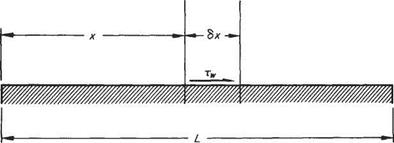Skin friction drag
The shear stress between adjacent layers of fluid in a laminar flow is given by r = p(du/dy) where du/dy is the transverse velocity gradient. Adjacent to the solid surface at the base of the boundary layer, the shear stress in the fluid is due entirely to viscosity and is given by p,(du/dy)v. This statement is true for both
laminar and turbulent boundary layers because, as discussed in Section 7.2.4, a viscous sublayer exists at the surface even if the main boundary-layer flow is turbulent. The shear stress in the fluid layer in contact with the surface is essentially the same as the shear stress between that layer and the surface so that for all boundary layers the shear stress at the wall, due to the presence of the boundary layer, is given by
![]() ’■’“"(I),
’■’“"(I),
where tw is the wall shear stress or surface friction stress, usually known as the skin friction.
Once the velocity profile (laminar or turbulent) of the boundary layer is known, then the surface (or skin) friction can be calculated. The skin-friction stress can be defined in terms of a non-dimensional local skin-friction coefficient, Q, as follows.
т„ = Сі1-РиІ (7.20)
Of particular interest is the total skin-friction force F on the surface under consideration. This force is obtained by integrating the skin-friction stress over the surface. For a two-dimensional flow, the force F per unit width of surface may be evaluated, with reference to Fig. 7.9, as follows. The skin-friction force per unit width on an elemental length (6x) of surface is
6F = tw6x
Therefore the total skin-friction force per unit width on length L is
![]() (7.21)
(7.21)
The skin-friction force F may be expressed in terms of a non-dimensional coefficient Cp, defined by
![]()
 |
F=CF^pUlSw
where Sw is the wetted area of the surface under consideration. Similarly for a flat plate or aerofoil section, the total skin-friction drag coefficient Сдр is defined by
![]() Df = CDf-PUl
Df = CDf-PUl
where Df = total skin-friction force on both surfaces resolved in the direction of the free stream, and S = plan area of plate or aerofoil. For a flat plate or symmetrical aerofoil section, at zero incidence, when the top and bottom surfaces behave identically, Df = 2F and S = Sv, (the wetted area for each surface). Thus
When flat-plate flows (at constant pressure) are considered, Ue = U^. Except where a general definition is involved, Ue will be used throughout.
Subject to the above condition, use of Eqns (7.20) and (7.22) in Eqn (7.21) leads to
Equation (7.25) is strictly applicable to a flat plate only, but on a slim aerofoil, for which Ue does not vary greatly from over most of the surface, the expression will give a good approximation to Cf-
We have seen in Eqn (7.11) how the boundary-layer thickness varies with Reynolds number. This result can also be used to show how skin friction and skin-friction drag varies with ReL. Using the order-of-magnitude estimate (7.3) it can be seen that
du /j, Ue p>Ux /——
tw = р,— ос – г – oc ——- y/ReL
ду о L
But, by definition, ReL = pUxLjp, so the above becomes
It therefore follows from Eqns (7.20) and (7.25) that the relationships between the coefficients of skin-friction and skin-friction drag and Reynolds number are identical and given by
Example 7.1 Some engineers wish to obtain a good estimate of the drag and boundary-layer thickness at the trailing edge of a miniature wing. The chord and span of the wing are 6 mm and 30 mm respectively. A typical flight speed is 5m/s in air (kinematic viscosity = 15 x 10~6 m2/s, density =1.2 kg/m3). They decide to make a superscale model with chord and span of 150 mm and 750 mm respectively. Measurements on the model in a water channel flowing at 0.5m/s (kinematic viscosity = 1 x 10-6 m2/s, density = 1000kg/m3) gave a drag of 0.19N and a boundary-layer thickness of 3 mm. Estimate the corresponding values for the prototype.
The Reynolds numbers of model and prototype are given by
 |
Evidently, the Reynolds numbers are not the same for model and prototype, so the flows are not dynamically similar. But, as a streamlined body is involved, we can use Eqns (7.11) and (7.27). From Eqn (7.11)
and from Eqn (7.27)
1/2
 |
||
But D[ = і pU^SCof. So, if we assume that skin-friction drag is the dominant type of drag and that it scales in the same way as the total drag, the prototype drag is given by











